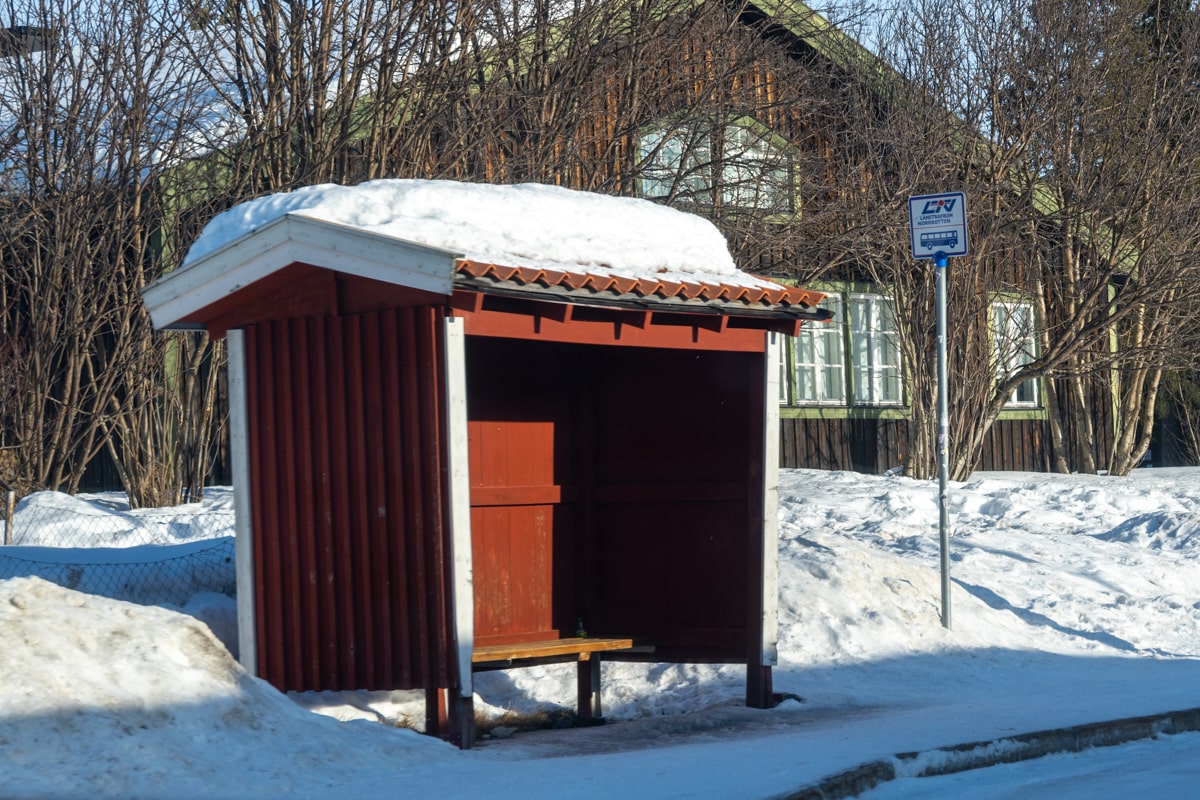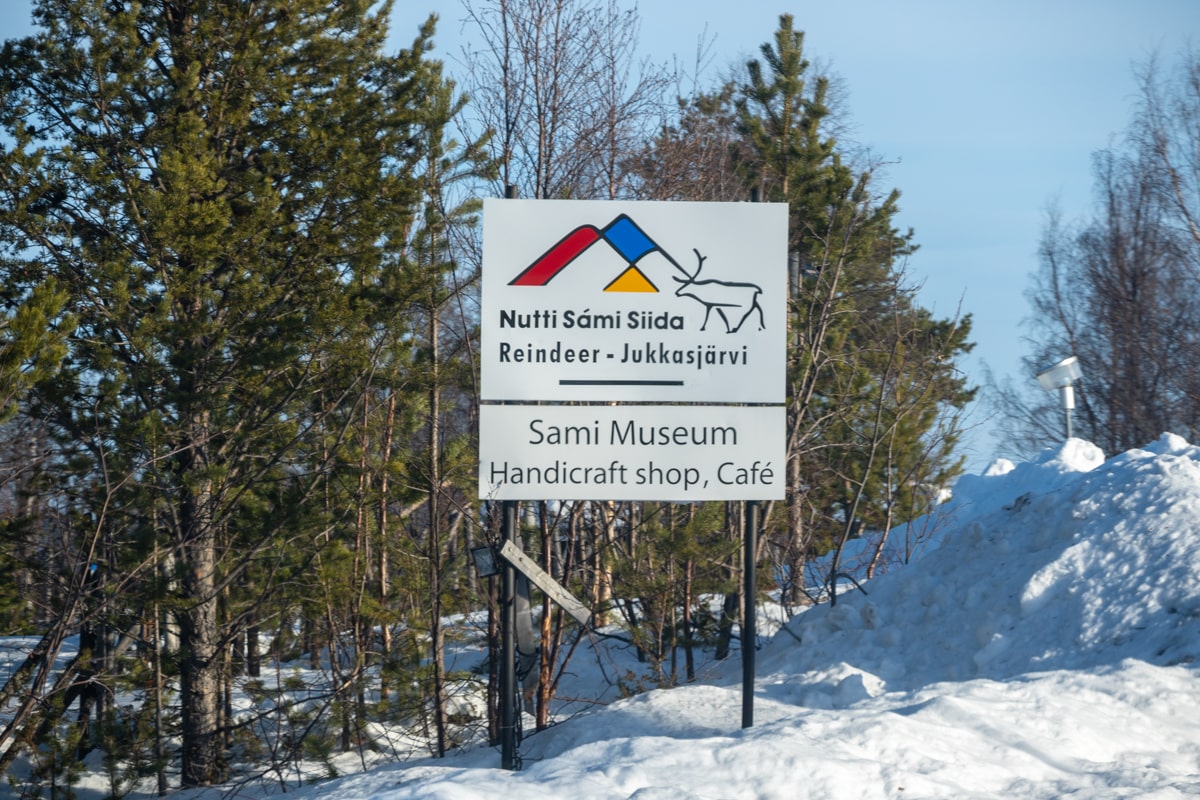In Jukkasjärvi, near the famous Ice Hotel, you’ll find an open-air museum dedicated to the history of the local population: the sámis. It’s called Márkanbáiki, meaning “market place”, because that’s where the town originated.
Indeed, long ago, it was here, on the banks of the Thorne River, that the sámis gathered to sell their possessions and creations. Here you can learn more about this little-known people. You can also buy some souvenirs, eat a traditional meal and even stroke some reindeer !
In this article, we’ll explain in detail all the practical information you need to know about the Jukkasjarvi Sami Museum, and what you can actually do there.
Practical information about the Sámi Museum in Jukkasjärvi
Here’s what you need to know before setting off for the sámi museum.
Admission prices
If you go to the Jukkasjärvi Museum, the rates are as follows:
- Adult: €20.00
- Children aged 3 to 12 inclusive: €9.50
- Students and senior citizens (65 and over): €15.00
Please note that the price of admission to the museum is different from the price of the meal, which you’ll have to pay extra for!
Take advantage of this activity to immerse yourself in the heart of Sámi culture. A van will pick you up in front of your hotel and drop you off in front of the museum. Afterwards, you'll be able to enjoy the museum fora day. Open-air museum, reindeer corral, traditional restaurant and craft store... You'll enjoy discovering this unique culture, and will leave with many fond memories.
Opening hours of the Jukkaskarvi Sami Museum
The open-air museum and gift store are open daily from 10am to 5:30pm. The restaurant is open from 11 a.m. to 11 p.m., but depending on the time of day you visit, you’ll be served differently: lunch from 11 a.m. to 4 p.m., fika break from 4 to 6 p.m. and dinner from 6 to 11 p.m.

Visit duration
If you want to visit the open-air museum, see the reindeer, buy a few souvenirs in the store and have a hot meal in the Sápmi café, allow 2 full hours for this cultural tour.
How do I get there?
If you’re driving from Kiruna, simply follow the E10 towards Jukkasjärvi. Then you’ll have to pass the Ice Hotel, which is very well signposted, and drive on for another 900 meters or so.
You’ll then come to a roundabout, on which stands the Jukkasjärvi church and museum. You can then park in front of it, although spaces are sometimes a little limited at busy times, but never enough to get stuck.
You can also get here by bus, taking route 501 and stopping at Jukkasjärvi Kyrkan. The journey from Kiruna takes around forty minutes.
On foot, from the Ice Hotel or the center of Jukkasjärvi, allow around 15 minutes . If it snows, be careful not to slip!


What can you see in Jukkasjärvi’s Sámi Museum?
There are three main areas to visit if you wish to tour the museum.
The Márkanbáiki
This open-air museum presents in detail the traditional lifestyle of the Sámi people: culture, traditions, clothing, tools, housing… You’ll learn a lot about this nomadic reindeer herding people.
You’ll also discover the many art and craft forms that punctuated their history. The visit is fun and suitable for everyone, thanks in particular to the small educational play area for children.
The tour is pleasant and fast-paced, thanks to the many explanatory panels dotted around the site.





At the end of the tour, you can also visit the reindeer from the Sámis herds. Very friendly, you can observe them and even stroke them.
At the museum entrance, in the store, you can also buy lichen, their main food, to feed them.
You’ll notice that these reindeer are quite small , but their feet are wide, making it easier to walk in the snow and dig for food.


Souvenir store
At the entrance to the museum, where you buy your tickets and enter the Sápmi café, you’ll find a charming little store stocked with handicrafts and other items related to Sámi culture.
Wooden objects, cosmetics, knives, food and accessories… Everything is designed to immerse you in this boreal universe. What’s more, by buying these handicrafts, you’ll be supporting the local population.


Café Sápmi
Next to the open-air museum is a typical restaurant, the Café Sápmi. Housed in a huge tepee, you can sit around large wooden tables.
Warmed only by the heat of a gigantic wood fire, you can relax and order your meal. Reindeer burger, traditional soup and hot cranberry juice, you’ll enjoy discovering the flavors of this boreal cuisine.
Recipes and ingredients are seasonal, and meals are cooked on site. You can go there for lunch, dinner and even the famous fika break, a traditional break during which Swedes gather to spend time together.
Vegetarian and vegan options are also available.



Who are the Sámi people?
The Sámi people are an indigenous group living in Lapland. This region of the world stretches across several Scandinavian countries, between Russia, Finland, Sweden and Norway. Today, there are some 80,000 Sámis spread throughout Lapland.
This indigenous people have a rich history and culture dating back thousands of years. Indeed, they are considered one of the oldest peoples in Europe.
Over the ages, they have succeeded in developing a culture and way of life adapted to theharsh Arctic environment in which they live.Reindeer herding plays a central role in their traditional way of life, providing meat, milk and materials for handicrafts.
It’s a particularly important animal for this community, which elevates it to symbolic status.

There are several Sámi dialects , depending on the region, and most locals know how to use them. Their culture is rich in tradition and art.
They are known for their joik, a form of traditional singing that is an important means of cultural expression. They are also known for their colorful traditional clothing, as well as for their handicrafts, called duodji with weavings, jewelry and carved wooden objects. The revitalization of the Sámi language and culture is an important issue for the community.
Indeed, over the centuries, the sámi have faced many challenges and assimilation policies. Modernization, urbanization and environmental change have also had an impact on their traditional way of life.
In recent years, however, there has been a revival of pride in and claim to the Sámi identity, with efforts to preserve and promote their culture, language and rights as an indigenous people.
Sámi organizations, political movements and initiatives have been created to represent and defend the interests of this people. Issues such as their rights over Lapland, natural resource management and environmental preservation are at the heart of the Sami community’s concerns.

The article on the Sámi Museum in Jukkasjärvi is now complete. This is a very enjoyable cultural visit, and you’ll enjoy learning more about this little-known indigenous people , so rich in history and tradition.
With its museum, souvenir store and café-restaurant, you’re sure to have a great time in this place full of history.